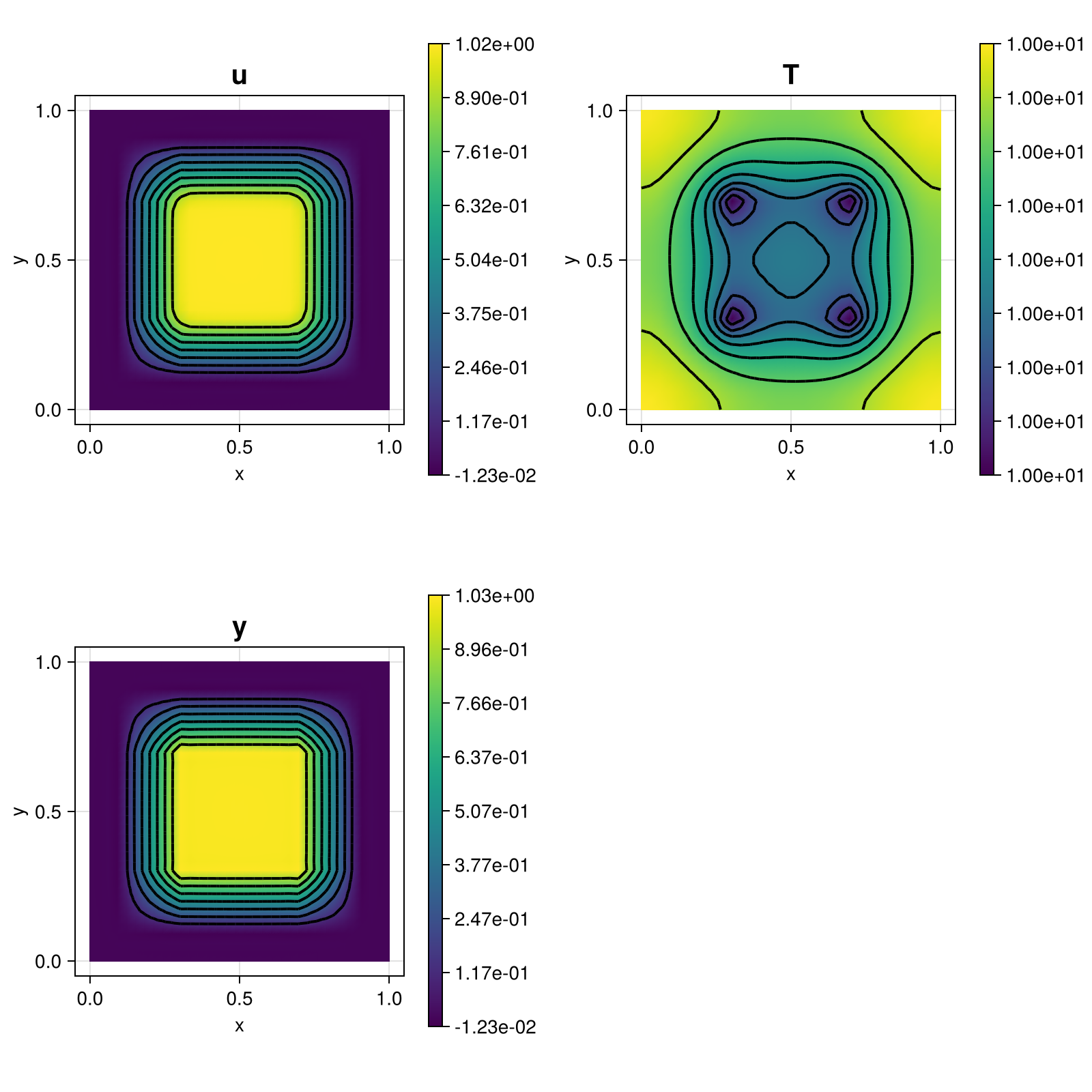226 : Thermoforming
This implements the thermoforming example taken from https://arxiv.org/abs/1802.03564 Section 6.4. The computed solution for the default parameters looks like this:

module Example226_Thermoforming
using ExtendableFEM
using ExtendableGrids
using SparseArrays
using LinearAlgebra
function w(r)
if 0.1 ≤ r ≤ 0.3
return 5.0 * r - 0.5
elseif 0.3 < r < 0.7
return 1.0
elseif 0.7 <= r <= 0.9
return 4.5 - 5.0 * r
else
return 0.0
end
end
# initial mould
function Φ0(x)
return w(x[1]) * w(x[2])
end
function g(r,κ,s)
if r <= 0.0
return κ
elseif r <= 0.25 * s
return κ - 8.0 * κ * r^2 / (3.0 * s^2)
elseif r <= 0.75 * s
return 7.0 / 6.0 * κ - 4.0 / 3.0 * κ * r / s
elseif r <= s
return 8.0 / 3.0 * (s - r)^2 / s^2
else
return 0.0
end
end
# The smooth bump function in [0,1]
bump(x) = (0.0 <= x <= 1.0) ? exp(-0.25 / (x - x^2)) : 0.0
# Bump in [0,1]^2
bumpInUnitSquare(x) = begin
r = sqrt((x[1] - 0.5)^2 + (x[2] - 0.5)^2)
return bump(0.5 + r)
end
# nonlinear kernel
function nonlinear_kernel!(result, input, qpinfo )
# results and input contain 7 variables (u,∇u,T,∇T,y)
u = view(input, 1)
∇u = view(input, 2:3)
T = view(input, 4)
∇T = view(input, 5:6)
y = view(input, 7)
α = qpinfo.params[1]
k = qpinfo.params[2]
f = qpinfo.params[3]
β = qpinfo.params[4]
κ = qpinfo.params[5]
s = qpinfo.params[6]
result[1] = α * max(0, u[1] - y[1]) - f # pattern: 1 7
result[2:3] = ∇u # pattern: 2 / 3
result[4] = k*T[1] - g(y[1]-u[1],κ,s) # pattern: 1 4 7
result[5:6] = ∇T # pattern: 5 / 6
result[7] = y[1] - Φ0(qpinfo.x) - β * bumpInUnitSquare( qpinfo.x ) * T[1] # pattern: 4 7
end
# custom sparsity pattern for the jacobians of the nonlinear_kernel (Symbolcs cannot handle conditional jumps)
# note: jacobians are defined row-wise
rows = [1, 1, 2, 3, 4, 4, 4, 5, 6, 7, 7]
cols = [1 ,7, 2, 3, 1, 4, 7, 5, 6, 4, 7]
vals = ones(Bool, length(cols))
sparsity_pattern = sparse(rows,cols,vals)
function main(;
κ = 10,
s = 1,
α = 1e8,
k = 1,
β = 5.25e-3,
f = 100,
N = 32,
order = 1,
Plotter = nothing,
kwargs...)
# choose mesh,
h = 1/(N+1)
xgrid = simplexgrid(0:h:1,0:h:1)
# problem description
PD = ProblemDescription()
u = Unknown("u"; name = "membrane position")
y = Unknown("y"; name = "mould")
T = Unknown("T"; name = "temperature")
assign_unknown!(PD, u)
assign_unknown!(PD, y)
assign_unknown!(PD, T)
assign_operator!(PD, NonlinearOperator(nonlinear_kernel!, [id(u), grad(u), id(T), grad(T), id(y)]; bonus_quadorder=2, params=[α,k,f,β,κ,s], sparse_jacobians_pattern=sparsity_pattern, kwargs...))
assign_operator!(PD, HomogeneousBoundaryData(u; regions = 1:4, kwargs...))
assign_operator!(PD, HomogeneousBoundaryData(y; regions = 1:4, kwargs...))
# create finite element space
FES = FESpace{H1Pk{1, 2, order}}(xgrid)
FESs = [FES, FES, FES]
sol = FEVector(FESs; tags = [u,y,T])
# initial guess for Newton
interpolate!(sol[u], (result,qpinfo) -> ( result[1] = 0.9*Φ0(qpinfo.x) ) )
interpolate!(sol[T], (result,qpinfo) -> ( result[1] = 0.2 ) )
interpolate!(sol[y], (result,qpinfo) -> ( result[1] = 10.0 ) )
# solve
sol = solve(PD, FESs; init = sol, maxiterations=420, target_residual=1e-8, kwargs...)
# plot
plt = plot([id(u),id(T),id(y)], sol; Plotter = Plotter)
return sol, plt
end
end # moduleThis page was generated using Literate.jl.